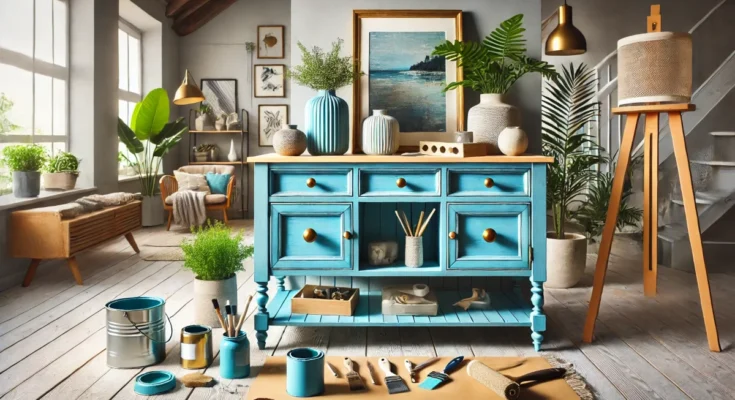What if we could repurpose old furniture into stunning, stylish home décor that feels both personal and one-of-a-kind? By giving tired pieces a second life with a little paint, stain, and decorative knobs, we can create something truly unique. Not only is this budget-friendly, but it’s also an eco-friendly way to refresh our spaces while reducing waste. All it takes are a few simple tools—paintbrushes, sandpaper, and some eye-catching hardware—to turn forgotten furniture into a centerpiece we’ll love. Let’s explore how to transform old furniture into beautiful, custom décor that adds personality to any room!
Why Repurpose Old Furniture?
Repurpose old furniture to give your home a fresh, stylish look while making a positive impact on the environment. Upcycling reduces waste, keeps furniture out of landfills, and supports sustainable living. By reimagining old pieces, we can create something unique that reflects our personal style. Imagine turning a worn dresser into a chic console table or giving a dated coffee table a trendy, colorful finish. These transformations not only elevate your home décor but also add charm and character to your space.
Old furniture often has better craftsmanship than many modern options, featuring solid wood construction and intricate details. Repurposing allows us to preserve these qualities while giving the piece a modern twist. Instead of buying mass-produced items, we can customize pieces to fit our exact needs. A fresh coat of paint, a vibrant stain, or new decorative knobs can completely transform a piece into something stylish and functional.
Creativity plays a huge role in upcycling. With a little imagination, a discarded cabinet door could become a decorative wall piece, or an old chair could be turned into a planter. The possibilities are endless, and each project becomes a unique expression of creativity. When we repurpose old furniture, we’re not just saving money; we’re also creating personalized pieces that make our homes more beautiful, sustainable, and meaningful.
Essential Tools and Materials
To successfully repurpose old furniture, having the right tools and materials makes all the difference. Start with paint, such as chalk or acrylic, for versatile finishes. Chalk paint creates a matte, vintage look, while acrylic paint offers a smoother, vibrant finish. Stains are great for enhancing natural wood grain, and sealants protect your work from wear and tear.
Decorative drawer knobs and hardware are essential for adding character. Choose unique options like glass, metal, or ceramic to complement your furniture’s style. Sandpaper is necessary for smoothing surfaces and removing old finishes, while quality brushes ensure even paint or stain application. Prepping tools, like screwdrivers and wood filler, help fix loose parts or cracks before starting the makeover.
You can find affordable supplies at hardware stores, craft shops, or online marketplaces. Many thrift stores also offer discounted hardware and leftover paint. For decorative knobs, check out specialty shops or online retailers offering unique designs. By having these tools and materials ready, you can repurpose old furniture with ease and create pieces that look stylish and professional.
Step-by-Step Guide to Repurposing Old Furniture
Transforming outdated furniture into stunning, functional pieces is easier than you think! Our step-by-step guide will show you how to repurpose old furniture using simple techniques like painting, staining, and updating hardware. Whether you’re breathing new life into a well-loved dresser or adding flair to a coffee table, this process is both fun and rewarding. With a little preparation, creativity, and the right tools, you can create personalized pieces that enhance your home décor. Let’s dive in and learn how to turn forgotten furniture into stylish, one-of-a-kind treasures!
Preparation
To repurpose old furniture effectively, start by thoroughly inspecting and cleaning the piece. Check for dirt, grime, or peeling finishes, and clean with mild soap and water. Next, sand the surfaces to remove old paint, stain, or imperfections. Use coarse sandpaper for heavy layers and finer grit for a smooth finish. Sanding ensures the new paint or stain adheres properly.
Examine the furniture for structural issues, such as loose screws or broken joints. Tighten any loose parts with a screwdriver or wrench. If there are cracks or missing pieces, use wood filler or glue to make repairs. Allow the filler to dry completely before moving on. Proper preparation ensures a sturdy base and long-lasting results for your repurposed furniture.
Painting and Staining
Choosing the right paint or stain is crucial for achieving your desired look. Chalk paint is great for a matte, vintage feel, while acrylic paint works well for vibrant, modern designs. Stain enhances the wood’s natural grain and adds warmth to the piece. Select colors or finishes that complement your home décor.
Apply paint in thin, even coats using a high-quality brush or foam roller. Allow each coat to dry before adding another to prevent streaks. For staining, apply with a clean cloth or brush, wiping off excess to control the depth of color. Always finish with a clear sealant to protect the surface.
Experiment with layering techniques for unique designs. For a distressed look, apply one paint color over another, then sand lightly in areas to reveal the base layer. This method adds character and depth to your furniture, making it truly one-of-a-kind.
Hardware Updates
Swapping out hardware is a simple yet impactful way to transform furniture. Decorative knobs, handles, or hinges can completely change the piece’s style. Choose hardware that matches your theme, such as vintage brass for a classic look or colorful ceramic for a playful touch.
When installing new knobs or handles, measure the placement carefully to ensure alignment. Use a drill to create holes if needed, and tighten screws securely. For older furniture, consider replacing hinges or drawer slides for improved functionality.
Mix and match hardware styles to add personality. For example, pair mismatched knobs on a dresser for a whimsical, eclectic vibe. Whether you go bold or subtle, updated hardware adds polish and style to your repurposed furniture.
Creative Ideas for Repurposing Furniture
Repurposing old furniture opens up endless possibilities to create unique and stylish pieces for your home. With a little creativity, you can transform an outdated dresser into a chic console table, revamp a coffee table with paint and stencils, or turn leftover cabinet doors into decorative wall art. Mixing colors, textures, and finishes adds personality to every piece, allowing you to customize furniture for any room. Whether you’re aiming for a vintage vibe or a modern look, these creative ideas will inspire you to see old furniture in a whole new way. Let’s start crafting something amazing!
Turn a Dresser into a Chic Console Table
Repurpose old furniture by transforming a bulky dresser into a sleek console table for your entryway or living room. Remove the top drawers to create open shelving for baskets or décor. Paint it in a bold color or use a wood stain for a natural look. Add decorative knobs to give it a polished finish. This functional yet stylish piece can serve as a focal point in any space.
Revamp an Old Coffee Table with Paint and Stencils
Give an outdated coffee table a fresh look with paint and stencils. Start with a base coat of chalk paint for a matte finish. Use stencils to create intricate designs, such as geometric patterns or floral motifs, for added charm. Seal the piece with a clear topcoat to protect it from daily use. Experiment with contrasting colors or metallic accents to make the design pop.
Use Leftover Cabinet Doors as Decorative Wall Art
Leftover cabinet doors can be repurposed into unique wall art. Sand and paint the door in a color that complements your décor. Use stencils, decals, or hand-painted designs to add a personal touch. Attach hooks to create a functional key or jewelry holder. These creative pieces are perfect for adding character to a gallery wall or entryway.
Mix Colors, Textures, and Finishes
Mixing colors and textures adds personality to your projects. Pair a distressed wood finish with vibrant paint for a rustic-modern vibe. Use metallic hardware to contrast soft pastel hues for a chic, eclectic style. Layer stains and paints to create depth and dimension, making each piece truly one-of-a-kind.
Customize for Specific Rooms
Tailor your furniture transformations to suit specific spaces. For a bedroom, use soft colors and vintage hardware to create a cozy, nostalgic feel. In the living room, go for bold paint and sleek hardware for a modern, contemporary look. A repurposed vanity with a bright, cheerful color could brighten a bathroom or guest room.
By exploring creative ideas and personalizing your designs, you can repurpose old furniture into stunning, functional pieces that enhance every room.
Maintenance and Care for Repurposed Furniture
To keep repurposed old furniture looking fresh, regular dusting with a soft cloth is essential to prevent buildup and scratches. Clean painted or stained surfaces with a damp cloth and mild soap, avoiding harsh chemicals that could damage the finish. For high-use pieces, inspect regularly for chips or scuffs, and perform touch-ups with leftover paint or stain to maintain a polished look.
Applying a protective finish, such as polyurethane or wax, ensures durability and guards against scratches, spills, and fading. Choose a finish suitable for the furniture’s use, like a water-resistant sealant for tables or moisture-prone areas. Reapply protective coatings every few years to keep the surface looking new.
Avoid placing repurposed furniture in direct sunlight or near heat sources, as these can cause warping or fading. With simple maintenance, your repurposed pieces will remain beautiful and functional for years to come.
Final Insights
Repurposing old furniture offers countless benefits, from saving money to creating unique, personalized pieces that enhance your home décor. By upcycling, we contribute to sustainability and reduce waste, all while unleashing our creativity. Even small projects, like painting a chair or replacing drawer knobs, can make a big difference and boost your confidence.
Start small, experiment with colors and textures, and embrace the imperfections that make your creations one-of-a-kind. Repurpose old furniture to reflect your personality and meet your specific needs. The possibilities are endless, whether you’re updating a single piece or transforming an entire space.
For more inspiration, explore online tutorials, DIY blogs, or local workshops to expand your skills and ideas. Repurposing is about creativity and fun, so don’t hesitate to try something new. Your next stunning home décor piece could be hiding in your attic or local thrift store.
Frequently Asked Questions (FAQ) About Repurpose Old Furniture
1. What type of furniture is best to repurpose? Sturdy pieces made of solid wood are ideal for repurposing, as they are durable and easier to sand, paint, or stain. Avoid heavily damaged or particle board furniture unless you’re confident in making repairs.
2. Do I need special tools or skills to repurpose old furniture? You don’t need advanced skills! Basic tools like sandpaper, paintbrushes, and screwdrivers are sufficient for most projects. Online tutorials can guide beginners.
3. How can I make sure my repurposed furniture lasts? Use protective finishes like polyurethane or wax to seal your work and prevent damage. Regular cleaning and occasional touch-ups keep it looking fresh.






